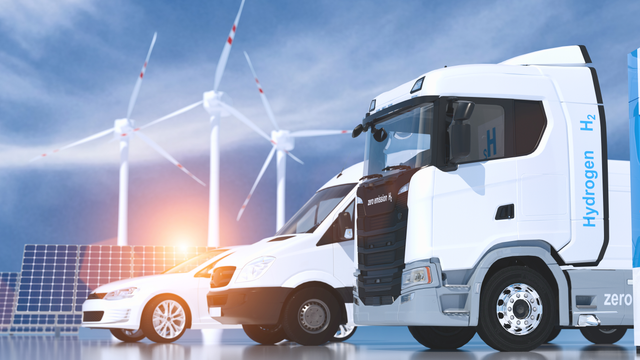Hydrogen-Powered Vehicles: Part of the Energy Transition?

As the world moves towards a more sustainable future, electric vehicle (EV) fleets are rapidly expanding across the United States. For commercial vehicles that drive short ranges during limited hours, electric vehicles are a great solution. However, for some fleets, today’s EVs may not provide enough range, or take too long to charge during business hours. Keeping an eye on zero-emission options, there is interest in alternative fuels, in particular hydrogen as a transportation fuel. Hydrogen fuel cell EV technology (FCEV) — already proven in vehicles including the Toyota Mirai and Nikola semi-trucks — is gaining steam due to quick refueling times, longer driving ranges, and zero greenhouse gas emissions.
But some still question whether hydrogen is a sustainable power source that could revolutionize the transportation industry or a logistical challenge that still needs development. As with every evolution, there is some truth in both perspectives.
Hydrogen is a colorless, odorless diatomic gas and the simplest and most abundant substance in the universe. Currently there is an estimated 78 million metric tons per annum of global demand and only 6% of global natural gas production is used for hydrogen production [1].
With demand and opportunities poised to collide, considering hydrogen is more than a pipe dream. Realistically evaluating the advantages and obstacles of transitioning to hydrogen unlocks opportunities that are both environmentally and economically advantageous.
ㅤ
FCEV’s Many Benefits
There are numerous benefits associated with the use of hydrogen as a fuel source. As renewable electricity is curtailed, hydrogen is becoming an increasingly attractive option.
Hydrogen is lighter than air and highly diffusive, meaning it disperses well in a ventilated area, making it a safe and efficient fuel source for transportation.
Fuel Cell Electric Vehicles (FCEVs) have range and refueling benefits over Battery Electric Vehicles (BEVs). In California alone, the FCEV market is projected to grow to 1 million FCEVs by 2030 [2].
The medium and heavy-duty vehicle market has seen significant investments over the last three years, indicating a growing interest in the use of hydrogen as a fuel source.
A shift towards decarbonization and consumer preferences has also contributed to the popularity of hydrogen fuel, with many electric utilities setting 2050 zero-emission targets.
As gigawatts of renewable electricity are curtailed, batteries cannot meet the demand for storage, making hydrogen an increasingly attractive option.
Co-product valorization of hydrogen is also a significant benefit, with carbon capture utilization storage and enhanced oil recovery being possible through Steam Methane Reforming (SMR), and oxygen through electrolysis.
ㅤ
And Some Hurdles to Overcome
There are several challenges facing the hydrogen industry. One, as with EVs, is the lack of infrastructure, particularly in transportation and storage.
Transportation costs can increase the cost of blue hydrogen (hydrogen produced from natural gas and supported by carbon capture and storage), making it less cost-effective. The blue hydrogen market is forecasted to at expand to over 11% Compound Annual Growth Rate (CAGR) by 2030 [3].
Green hydrogen (hydrogen obtained by electrolysis of water) production costs four times more than blue hydrogen with carbon capture and storage. Despite this, green hydrogen production is expected to grow at over 60% CAGR by 2030 [4].
There is a need for more economical, large-scale fuel cells and combustion turbines that can utilize hydrogen at over 60% efficiency.
Hydrogen storage and transmission are crucial for the industry. Pipelines are the most cost-efficient way to transport large quantities of hydrogen over long distances, and they can serve clustered refinery, chemical, and industrial uses. Access to underground storage is particularly attractive, and pipelines may also serve as a local distribution network.
For small demand dispersed in a region, gaseous tube trailers are the best option. However, gas compression and storage can be costly. Liquefied hydrogen tankers are suitable for serving long distances with no existing infrastructure. Although liquefaction needs scale and is costly, it saves storage and compression costs for the refueling stations.
Hydrogen fuel cell technology has the potential to help the transportation industry move to 100% zero-emission faster. While there are hurdles to overcome, such as infrastructure and production costs, the benefits of hydrogen as a fuel source are numerous. With continued investment and innovation, hydrogen is poised to become a significant player
As organizations explore zero-emission fleets, and the energy and infrastructure needed to support them, there are many considerations. Download the Black & Veatch guide, Fleet Decarbonization, for valuable insights.
[1] S&P Global Commodity Insights, 2023
[2] California Air Resources Board, 2022
[3] Global Market Insights, 2022
[4] Global Market Insights, 2022
Contact Us
Looking for a partner in innovation?
Let's Talk
